Australian Defence Force ranks
The Australian Defence Force's (ADF) ranks of officers and enlisted personnel in each of its three service branches of the Royal Australian Navy (RAN), the Australian Army, and the Royal Australian Air Force (RAAF) inherited their rank structures from their British counterparts. The insignia used to identify these ranks are also generally similar to those used in the British Armed Forces.
The following tables show the "equivalent rank and classifications" for the three services, as defined in the ADF Pay and Conditions Manual.[1] "Equivalent rank" means the corresponding rank set out under Regulation 8 of the Defence Force Regulations 1952.[2]
Commissioned officer ranks
| NATO Code | Aus/US Code | Navy | Army | RAAF |
|---|---|---|---|---|
| Flag/General/Air Officers[1][3] | ||||
| OF-10 | O-11[lower-alpha 1] | Admiral of the Fleet | Field Marshal | Marshal of the RAAF |
| OF-9 | O-10[lower-alpha 2] | Admiral | General | Air Chief Marshal |
| OF-8 | O-9[lower-alpha 3] | Vice Admiral | Lieutenant General | Air Marshal |
| OF-7 | O-8 | Rear Admiral | Major General | Air Vice Marshal |
| OF-6 | O-7[lower-alpha 4] | Air Commodore | ||
| Senior officers | ||||
| OF-6 | O-7[d] | Commodore | Brigadier | — |
| OF-5 | O-6[d] | Captain (RAN) | Colonel | Group Captain |
| OF-4 | O-5[d] | Commander | Lieutenant Colonel | Wing Commander |
| OF-3 | O-4[d] | Lieutenant Commander | Major | Squadron Leader |
| Junior officers | ||||
| OF-2 | O-3[d] | Lieutenant | Captain (Army) | Flight Lieutenant |
| OF-1 | O-2 | Sub Lieutenant | Lieutenant | Flying Officer |
| OF-1 | O-1 | Acting Sub Lieutenant | Second Lieutenant | Pilot Officer |
| — | O-0 | Midshipman | — | — |
| Cadets | ||||
| — | — | — | Officer Cadet/Staff Cadet(RMC) | Officer Cadet |
Warrant officer ranks
| NATO Code | Aus/US Code | Navy | Army | RAAF |
|---|---|---|---|---|
| Warrant officers | ||||
| OR-9 | E-9 | Warrant officer | Warrant Officer | Warrant officer |
| Warrant Officer Class 1 | ||||
| OR-8 | E-8 | — | Warrant Officer class 2 | — |
- Note that the most senior warrant officer in each of the three services is appointed either Warrant Officer of the Navy (WO-N), Regimental Sergeant Major of the Army (RSM-A), or Warrant Officer of the Air Force (WOFF-AF), as appropriate. These are appointments, not ranks; these three people hold the rank of Warrant Officer in their respective services. However, they each wear special insignia, different from the rank insignia worn by other warrant officers. Although the RAN and the RAAF have the one warrant officer rank, the army has three. The soldier appointed Regimental Sergeant Major of the Army (RSM-A) holds the unique Army rank of warrant officer (introduced in 1991 and senior to WO1). The Army rank of WO2 is the same pay grade as the RAN and the RAAF's most senior NCOs, (i.e. chief petty officer and flight sergeant).[1] As Army WO2s hold a Warrant, while the RAN CPO and RAAF FSTG do not, WO2s are addressed as "Sir" or "Ma'am" by junior ranks, which extends to OCDTs and SCDTs.
Non-commissioned officer ranks
| NATO Code | Aus/US Code | Navy | Army | RAAF |
|---|---|---|---|---|
| Senior non-commissioned officers | ||||
| OR-8 | E-8 | Chief Petty Officer | — | Flight Sergeant |
| OR-7 | E-7 | — | Staff sergeant[1][lower-alpha 5] | — |
| OR-6 | E-6 | Petty officer | Sergeant | Sergeant |
| Junior non-commissioner officers | ||||
| OR-5 | E-5 | Leading Seaman | Corporal/Bombardier | Corporal |
| OR-4 | E-4 | — | Lance Corporal/Bombardier | — |
Other ranks
| NATO Code | Aus/US Code | Navy | Army | RAAF |
|---|---|---|---|---|
| Enlisted | ||||
| OR-3 | E-3 | Able seaman | Private (Proficient) | Leading Aircraftman/woman |
| OR-2 | E-2 | Seaman | Private | Aircraftman/woman |
Insignia
Commissioned officers
The rank insignia for commissioned officers for the navy, army and air force respectively.
| Equivalent NATO code | OF-10 | OF-9 | OF-8 | OF-7 | OF-6 | OF-5 | OF-4 | OF-3 | OF-2 | OF-1 | OF(D) and student officer | |||||||||||||||||||||||||
|---|---|---|---|---|---|---|---|---|---|---|---|---|---|---|---|---|---|---|---|---|---|---|---|---|---|---|---|---|---|---|---|---|---|---|---|---|
 |
 |
 |
 |
 |
 |
 |
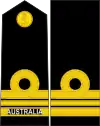 |
 |
 |
 |
.svg.png.webp)  | |||||||||||||||||||||||||
| Admiral of the fleet | Admiral | Vice admiral | Rear admiral | Commodore | Captain | Commander | Lieutenant commander | Lieutenant | Sub lieutenant | Acting sub lieutenant | Midshipman | |||||||||||||||||||||||||
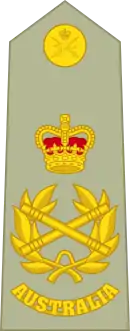 |
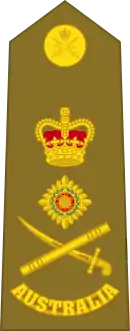 |
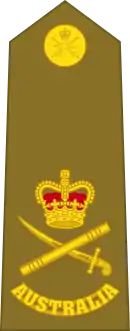 |
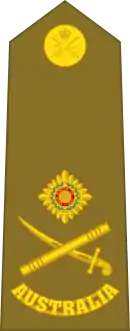 |
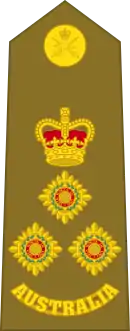 |
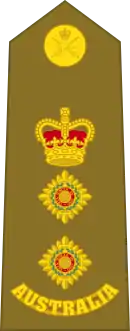 |
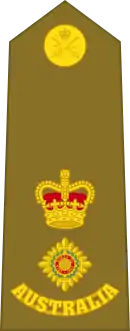 |
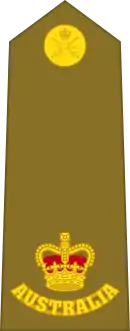 |
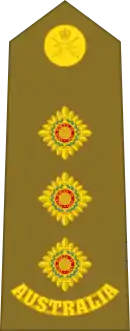 |
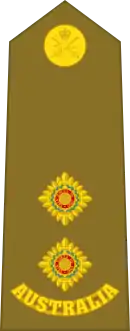 |
 |
_(OCDT).svg.png.webp) |
_(SCDT).svg.png.webp) | ||||||||||||||||||||||||
| Field marshal | General | Lieutenant general | Major general | Brigadier | Colonel | Lieutenant colonel | Major | Captain | Lieutenant | Second lieutenant | Officer cadet | Staff cadet | ||||||||||||||||||||||||
 |
 |
 |
 |
 |
 |
 |
 |
 |
 |
 |
.svg.png.webp) | |||||||||||||||||||||||||
| Marshal of the RAAF | Air chief marshal | Air marshal | Air vice-marshal | Air commodore | Group captain | Wing commander | Squadron leader | Flight lieutenant | Flying officer | Pilot officer | Officer cadet | |||||||||||||||||||||||||
| Equivalent NATO code | OF-10 | OF-9 | OF-8 | OF-7 | OF-6 | OF-5 | OF-4 | OF-3 | OF-2 | OF-1 | OF(D) and student officer | |||||||||||||||||||||||||
Enlisted
The rank insignia for enlisted personnel for the navy, army and air force respectively.
| Equivalent NATO code | OR-9 | OR-8 | OR-7 | OR-6 | OR-5 | OR-4 | OR-3 | OR-2 | OR-1 | |||||||||||||||||||||||||||
|---|---|---|---|---|---|---|---|---|---|---|---|---|---|---|---|---|---|---|---|---|---|---|---|---|---|---|---|---|---|---|---|---|---|---|---|---|
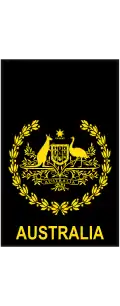 |
 |
 |
No equivalent |  |
 |
No equivalent |  |
 | ||||||||||||||||||||||||||||
| Warrant Officer of the Navy | Warrant Officer | Chief Petty Officer | Petty Officer | Leading Seaman | Able Seaman | Seaman | ||||||||||||||||||||||||||||||
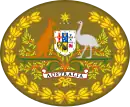 |
 |
 |
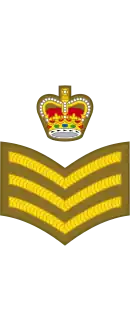 |
 |
 |
 |
No insignia | |||||||||||||||||||||||||||||
| Regimental sergeant major of the army |
Warrant officer class 1 |
Warrant officer class 2 |
Staff sergeant (Phased out as of 2019) |
Sergeant | Corporal | Lance corporal | Private (or equivalent) | |||||||||||||||||||||||||||||
 |
 |
 |
No equivalent |  |
 |
No equivalent |  |
 | ||||||||||||||||||||||||||||
| Warrant Officer of the Air Force | Warrant Officer | Flight Sergeant | Sergeant | Corporal | Leading Aircraftman | Aircraftman | ||||||||||||||||||||||||||||||
| Equivalent NATO Code | OR-9 | OR-8 | OR-7 | OR-6 | OR-5 | OR-4 | OR-3 | OR-2 | OR-1 | |||||||||||||||||||||||||||
See also
- Royal Australian Navy ranks and uniforms
- Australian Army officer rank insignia
- Australian Army enlisted rank insignia
- Royal Australian Air Force (RAAF) rank insignia
Notes
- O-11 ranks - admiral of the fleet, field marshal and marshal of the RAAF - may only be used in wartime and for honorary appointments.
- O-10 ranks - The Chief of the Defence Force is the sole O-10 ranked appointment.
- O-9 ranks - The Vice Chief of the Defence Force, Chief of Joint Operations, Chief of the Capability Development Executive and Chiefs of the Navy, Army and Air Force comprise the six O-9 ranked appointments.
- Chaplains:
- O-3 ranks - Chaplains are commissioned officers without rank, however they are accorded the rank of Captain (O-3) for reasons of protocol, ceremonial occasions and for saluting purposes.
- O-4/5 ranks - The more senior division 2 and 3 chaplains are accorded the rank of Major (O-4) and Lieutenant Colonel (O-5), respectively.
- O-6 ranks - The three Principal Chaplains representing the three major Christian denominations: Catholic, Anglican, and Protestant, are equivalent to a Colonel (O-6).
- O-7 ranks - The heads of the various churches and religions officially associated to the ADF's Religious Advisory Committee, such as the Anglican and Catholic Bishops of the Military, are equivalent to a Brigadier (O-7).
- Without prejudice to existing holders of the rank, the Army has ceased to promote soldiers to the rank of staff sergeant.[4]
References
- "ADF Pay and Conditions Manual (PACMAN)". People Strategies and Policy (AL13 ed.). Department of Defence, Australian Government. November 2009. p. 1.
- Defence Force Regulations 1952.
- Badges of Rank and Special Insignia. Commonwealth of Australia - Department of Defence. September 2003. pp. 2–3.
- "Australian Army Rank Structure, Other Ranks". army.gov.au. Australian Army. 25 October 2019. Archived from the original on 27 February 2020. Retrieved 25 January 2020.